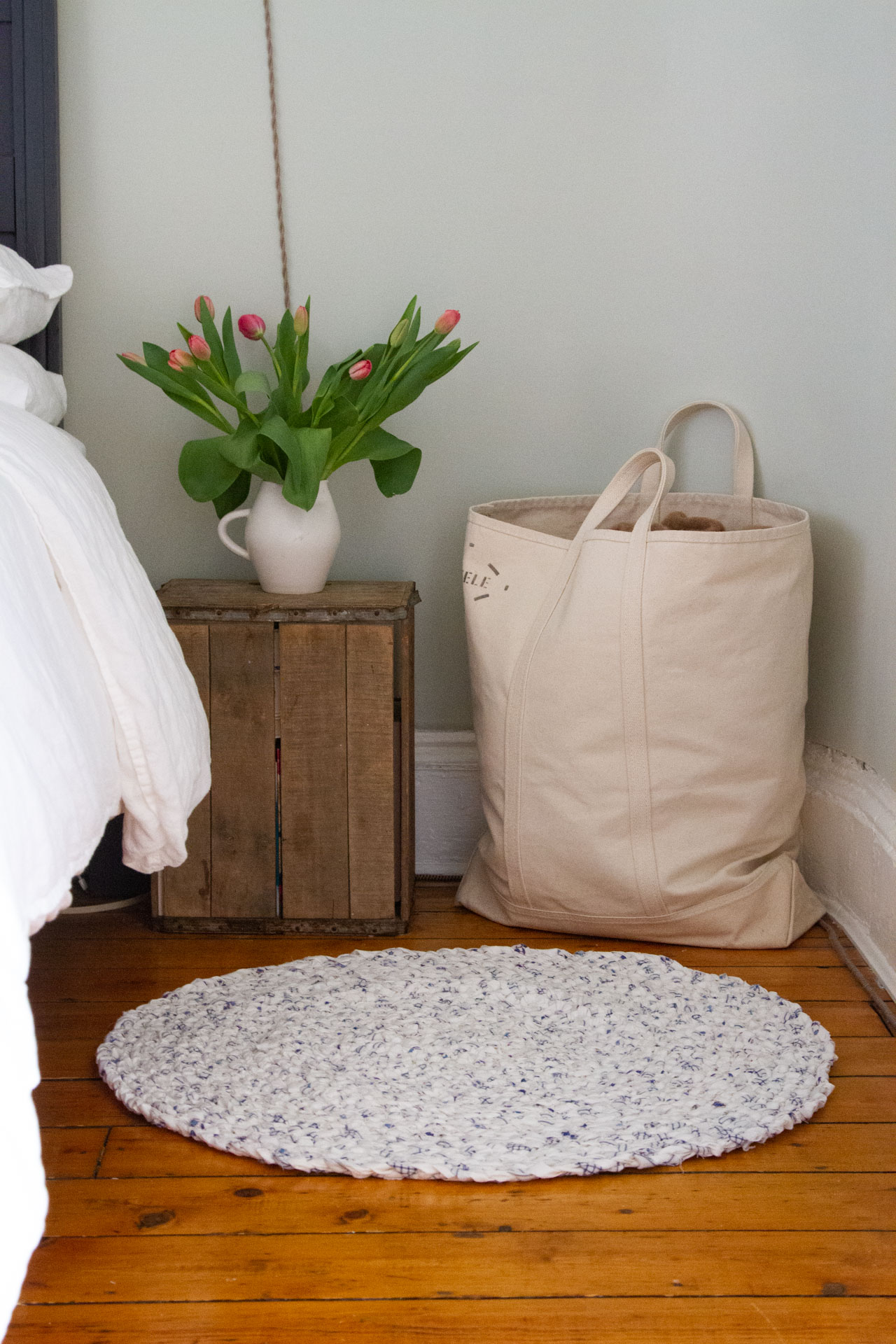
Five years since receiving and test-driving a bunch of new bed sheets , we find ourselves with a glut of ripped sheets. It started as a slow wear, a kind of general softening and stretching, but in the last few months, as if part of a choreographed revolt, the bottom sheets of three original sets have each torn. One of them ripped so dramatically I woke up startled by the rrrrrip of the cotton percale beneath me, my arm stuck through a hole. Another set of sheets—linen—deteriorated more subtly, slowly losing their color and getting more and more threadbare until one weekend morning, I held the sheet up to the light and realized it was virtually see-through and dotted with dime-sized holes.
What to do with a set of worn out sheets (to say nothing of three!)? Mending seems like an obvious solution, but the sheets were worn so thin by the time they tore that the effort of mending something that would rip again so easily felt futile. Adding large patches sounded impractical and uncomfortable. Options for recycling textiles exist, but they’re limited, and our own local textile collection service explicitly forbids depositing bed sheets.
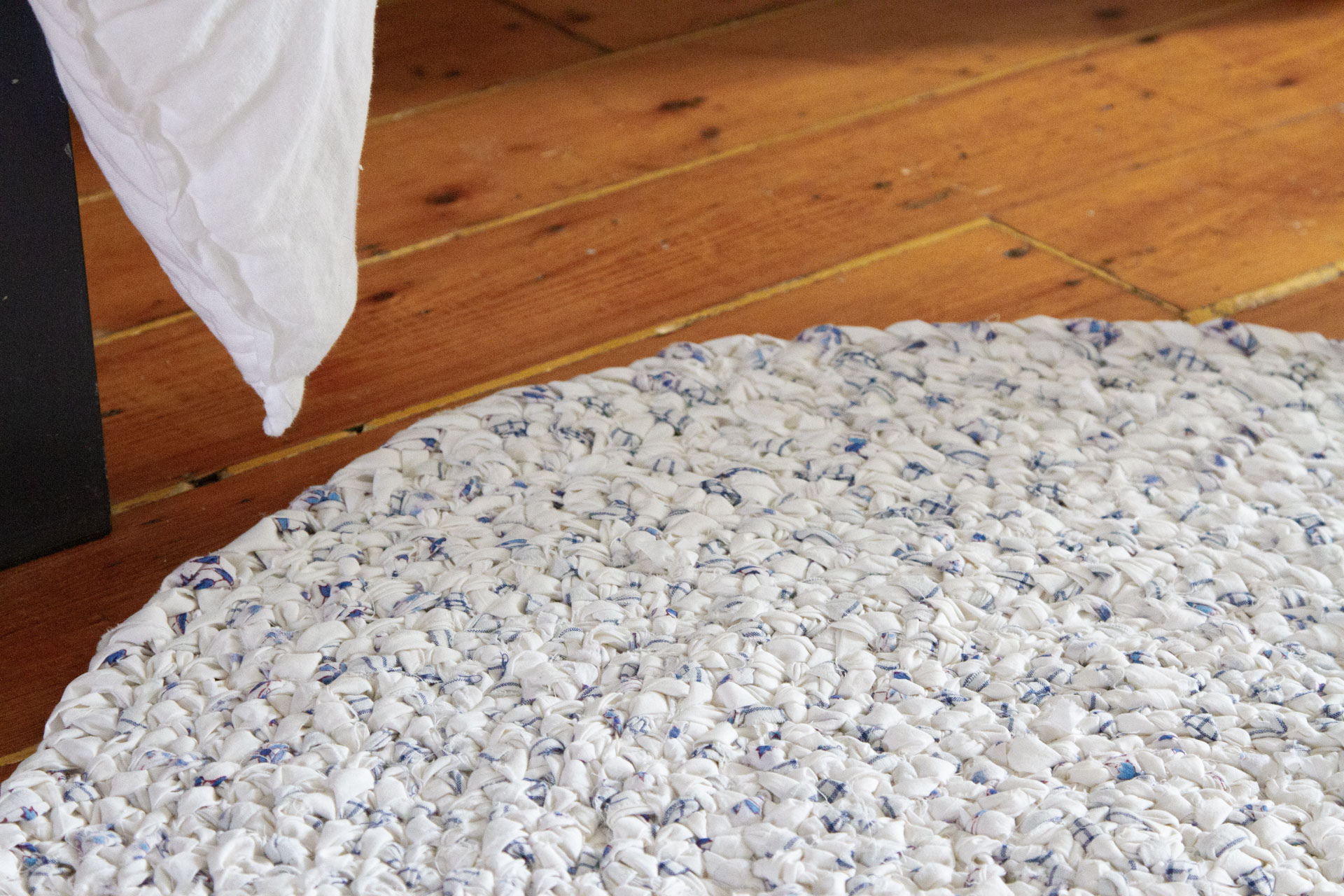
So, I decided to make a rug. I won’t suggest that braiding a rag rug is a quick and easy zero-waste solution to repurposing your used bedsheets. There’s nothing quick about making a rug, and while the actual process is easy enough, it’s a project that demands time and staying power, not to mention some muscles and balm for your soon-to-be tender pinky finger. At the end of many hours, I have one small rug (and still more ripped bedsheets). Still, making a rag rug is an exercise in breathing new life into something old, keeping precious resources in circulation, and learning a new skill. For me, that was reason enough to try.
Along with our torn cotton bedsheets, I decided to incorporate leftover cuts from curtains that I made for the French doors of our bedroom. The leftovers I had from that project were long and thin and difficult to imagine into much of anything else, but perfect for stripping down for braids.
Personally, I liked the classic flat coils of a braided and hand-laced rag rug best, so that’s what I made. I’ve tried to walk folks through my basic process below, but there’s more than one way to weave a rug—from Amish toothbrush rugs, to braid-in rag rugs, to woven beauties made complete with loom and shuttle—so don’t let me be the one to stop you from trying another route.
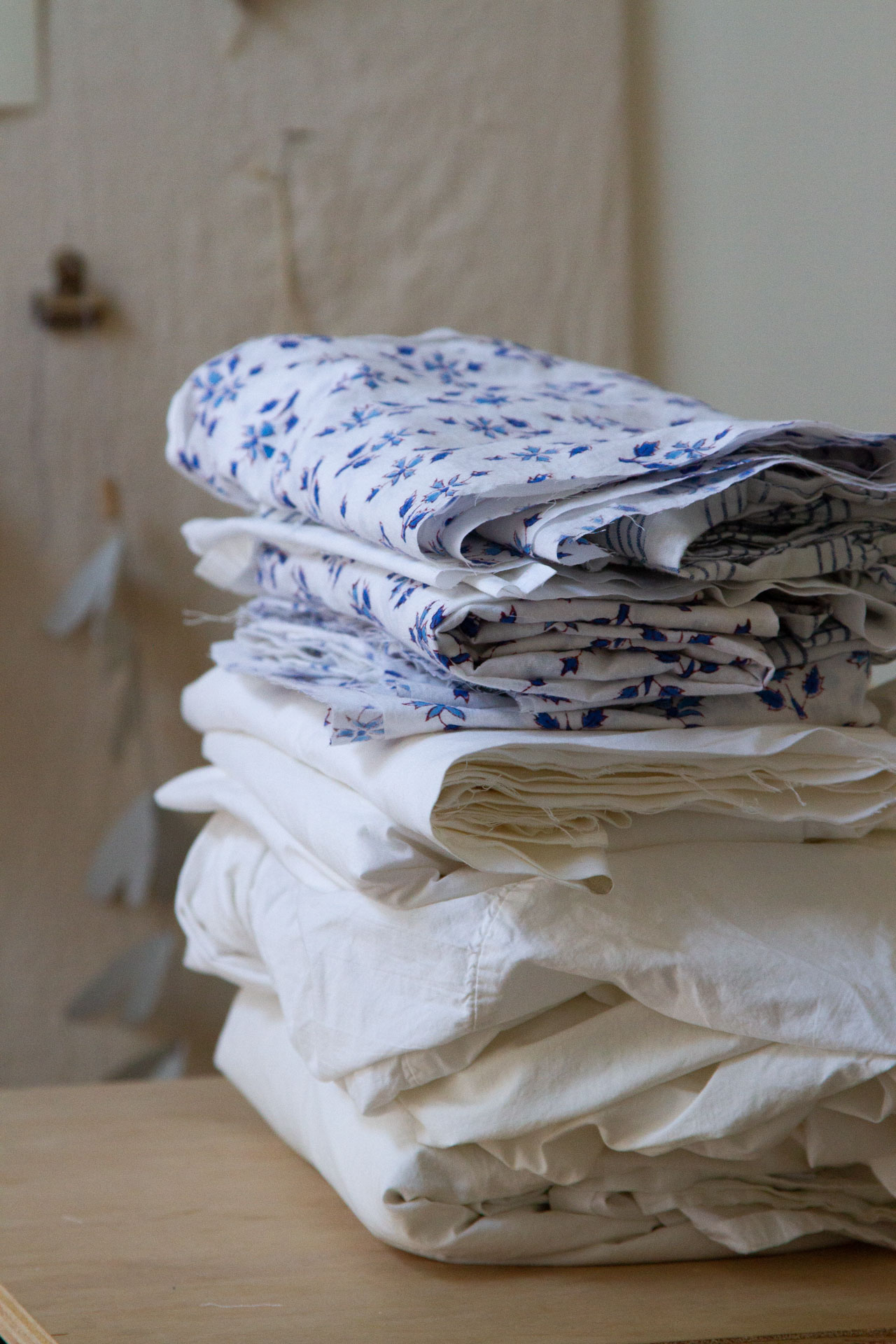
Prepping
I prepared my sheets and scrap fabric by tearing them by hand into roughly 2-inch wide strips. For me, the easiest, most efficient way to tear the sheets was to fold a length of fabric in half and cut starter snips along the top edge, two-inches apart. Then, I could tear through two lengths of fabric at once, getting twice the number of strips from the same amount of work.
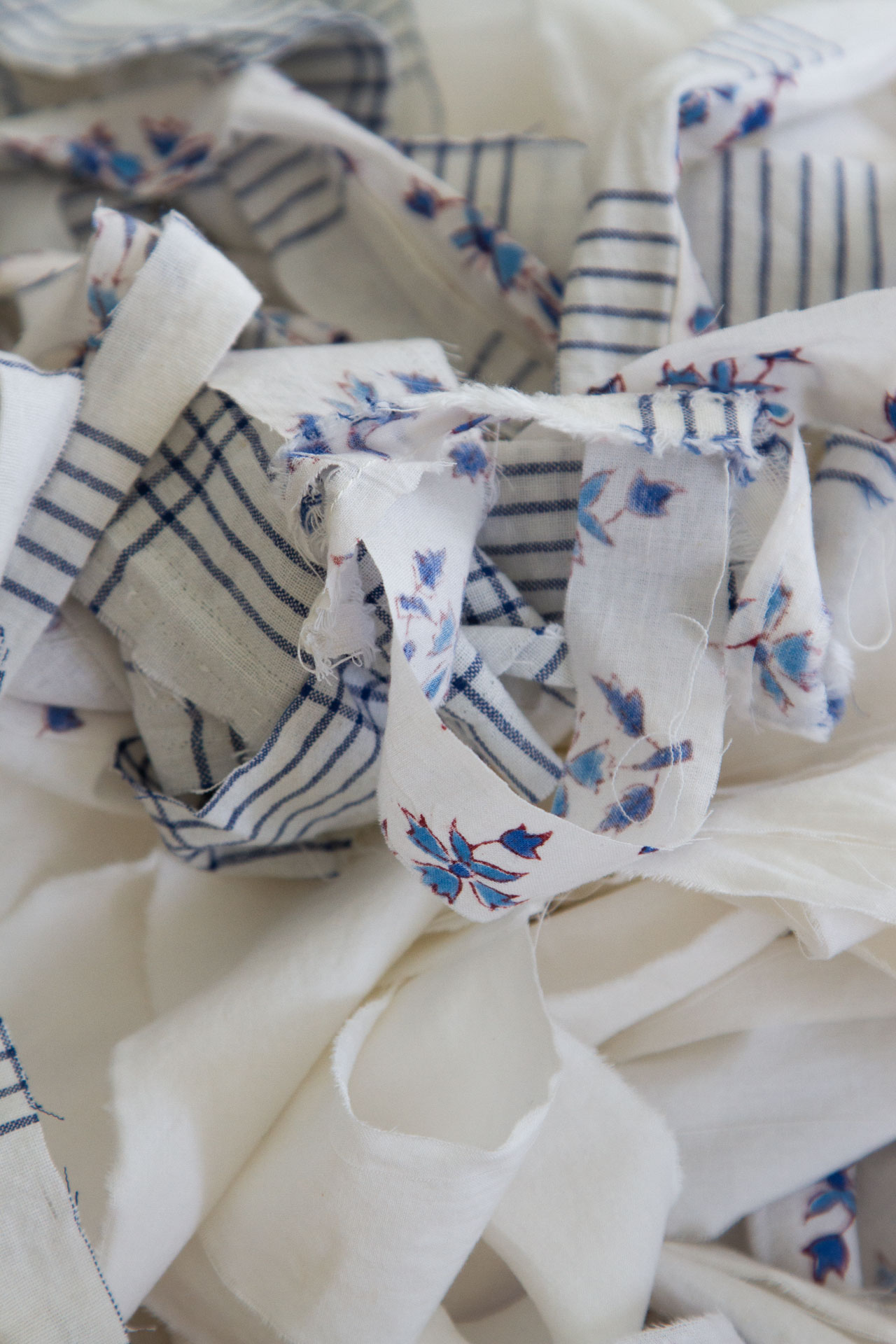
If your fabric doesn’t tear easily, a rotary cutter and a mat would be helpful, but plain old scissors also work. It should be noted that I did not measure my strips with a ruler or worry about precision. I did occasionally run my fingers down the length of a strip to get rid of shedding threads, but I generally took a laissez faire approach to both my strips and my braiding, not minding if the strips were perfectly the same size or if frayed edges peeked through the edges of the braids.
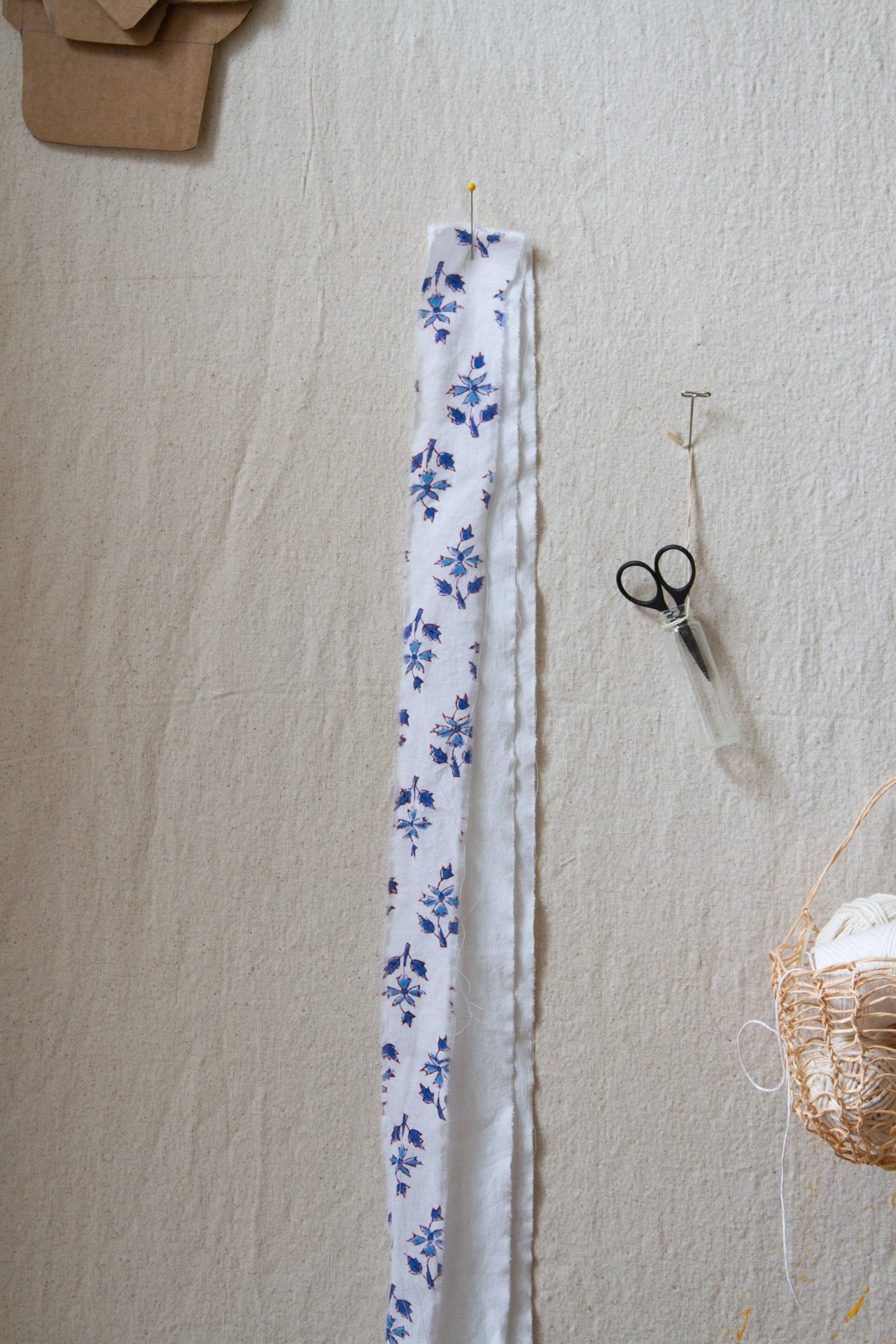
Braiding
The main thing to know when braiding is that it’s helpful to have strips of varying lengths to join together so you don’t end up with a lumpy rug. I used a very simple three-strand braid technique, overlaying left, center, and right-hand strands. I started with my braid safety pinned together and later sewed it with needle and thread. To achieve tension, you can pin or tape your braid to a surface while you work. I moved my braiding operation around the apartment, starting in bed in the evening, knees knocked together, braid wedged between them. Then I moved to a chair, cookbooks stacked on the braid. I ended up having the most success standing with my braid draped over the top of a door. It stayed taut that way and I could work with longer lengths of sheet that wouldn’t tangle as I braided. [I’ll add a video of my quirky process to Instagram should you want to take a look.]
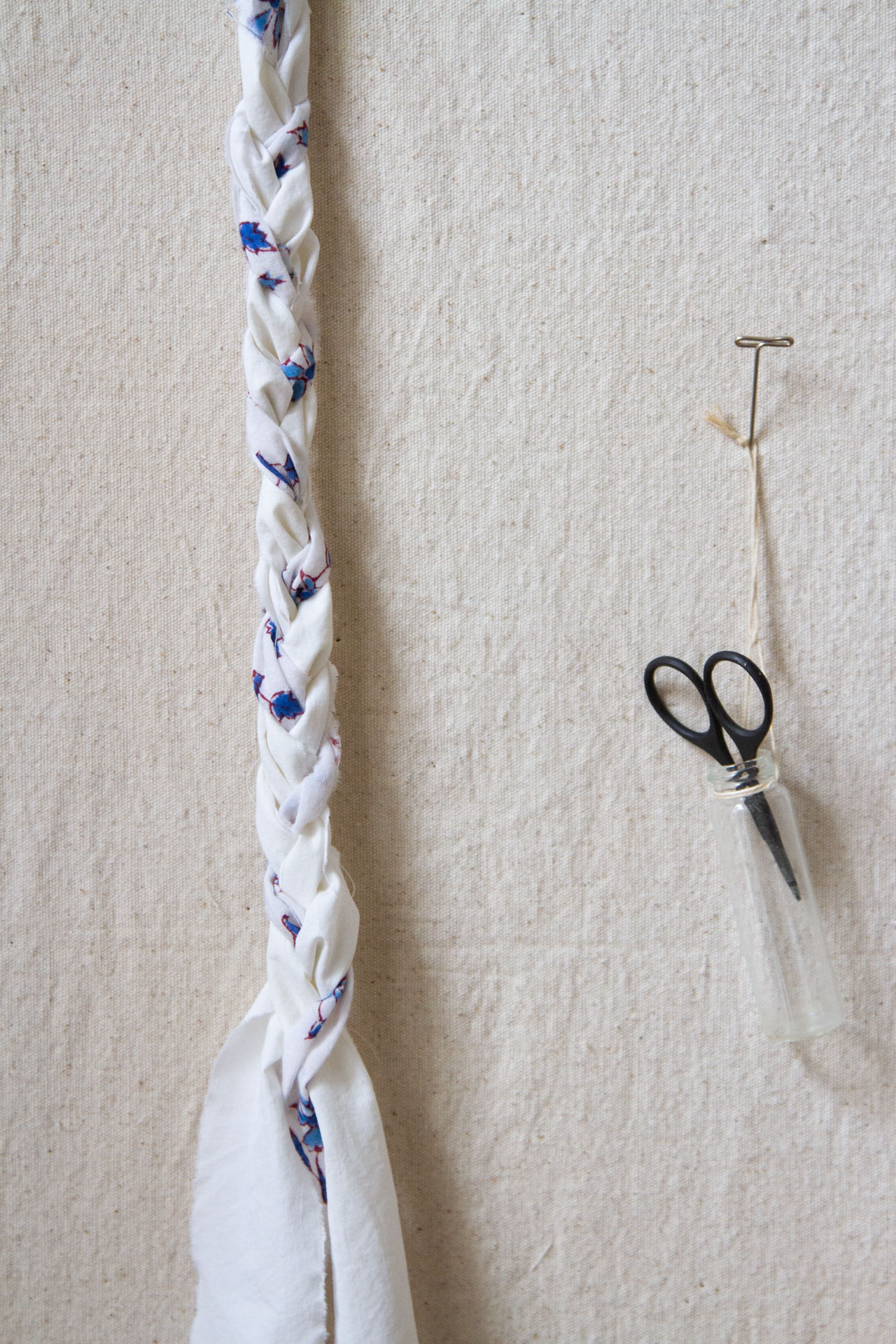
The particulars of fabric and braiding tension will mean this varies slightly, but I found that braiding three five-foot strips, yielded about four feet of braided rope. The strips sort of naturally fold in on themselves in the course of braiding and so I made a limited effort to coax them into folding folded edge-out, so the frayed edges tended toward the center of the braid. (Some rug makers iron their strips in half to have clean edges, but I didn’t feel compelled to do so.)
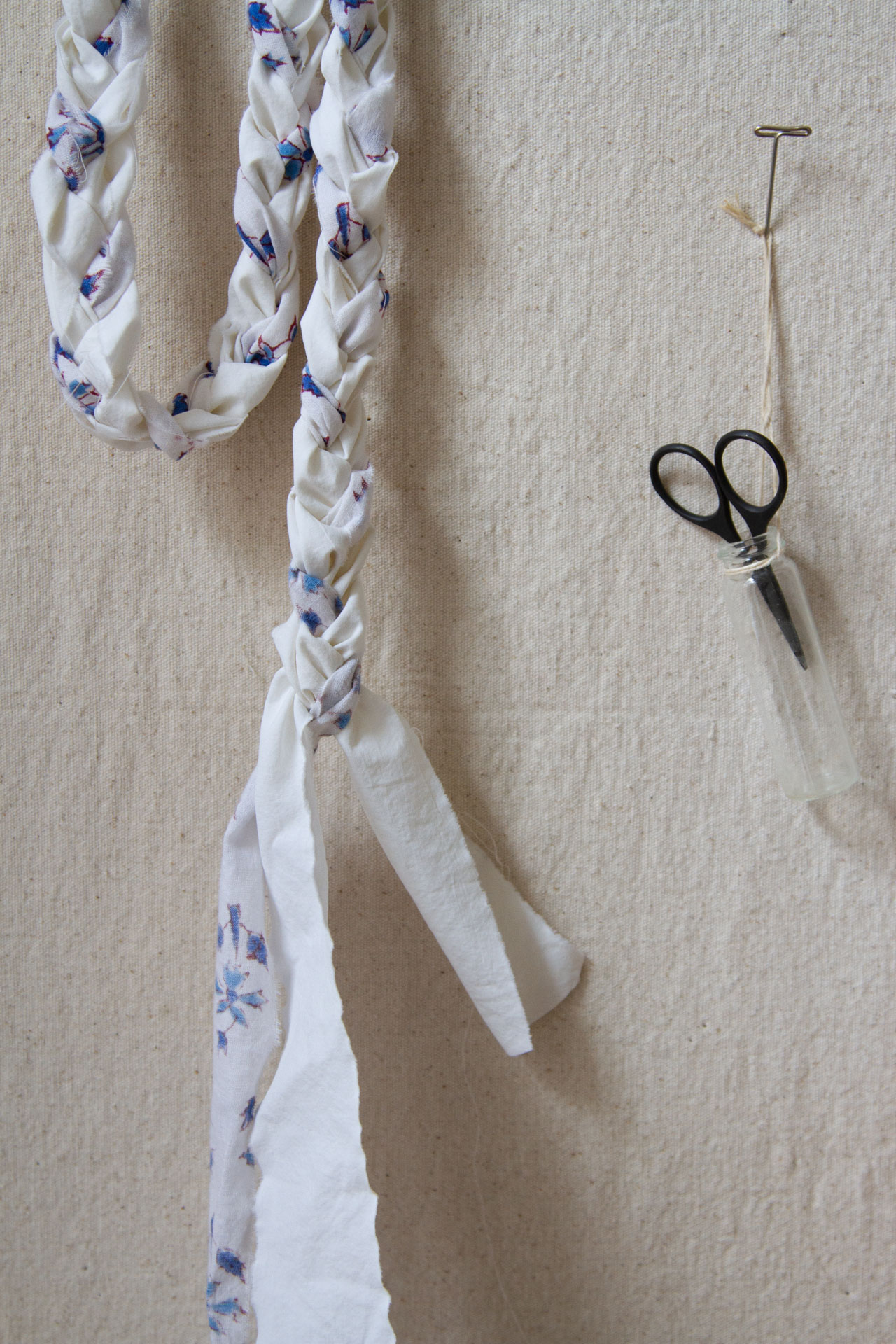
Joining
When I reached the end of one length of fabric strip, I added another strip with a simple rug joining technique that uses small slits cut into the ends of the fabric strips. Joining strips one by one means both that you won’t be braiding with too-long strips that get tangled and that you can space out the knots in your braid strands avoid bumps as you braid. Some folks sew the ends of each strip together as they work, but I found the below method to be quick and easy.
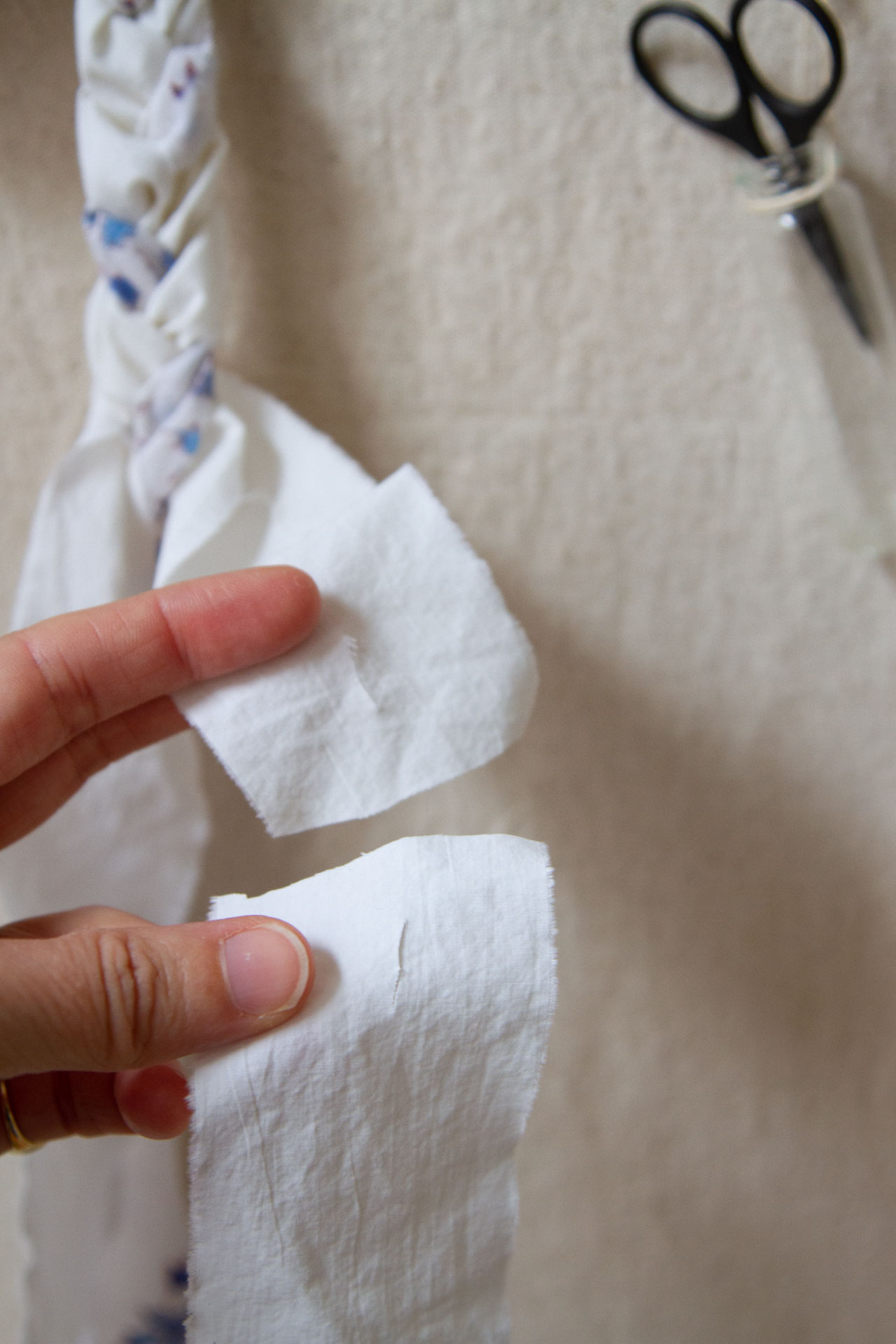
To join two strips, I cut roughly 1/4 inch slits in the ends of the fabric strip that’s braided and both ends of the fabric strip I planned to join to it. (Eventually every strip in the braid will need to have a slit in the top and bottom so you can choose to cut the slits all at once while prepping your fabric.)
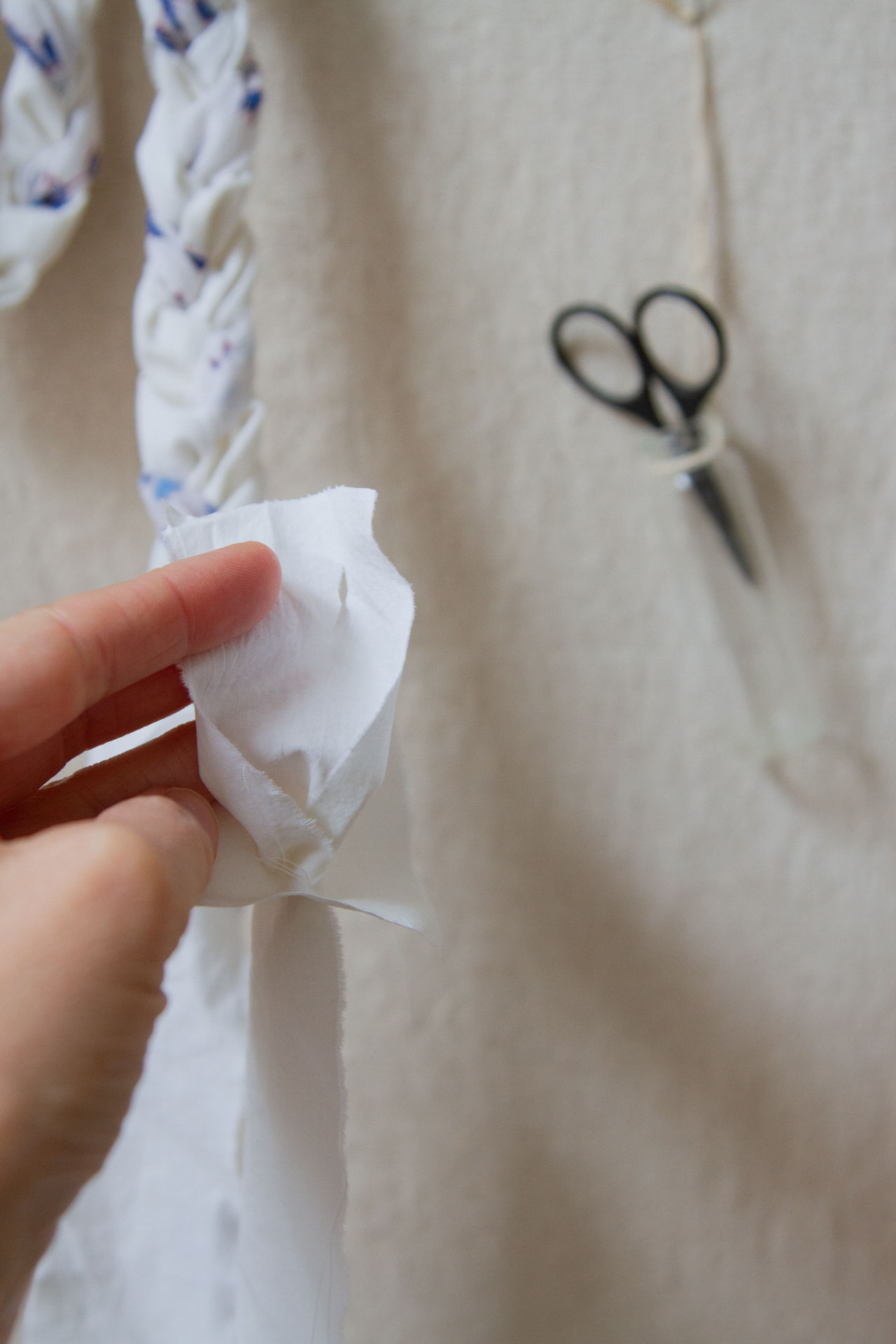
Next I pushed the end of the new strip through the hole in the base of the working strip, then took the opposite end of the new strip and pushed that end through the hole on its opposite end (the end I had pushed through the end of the working strip).
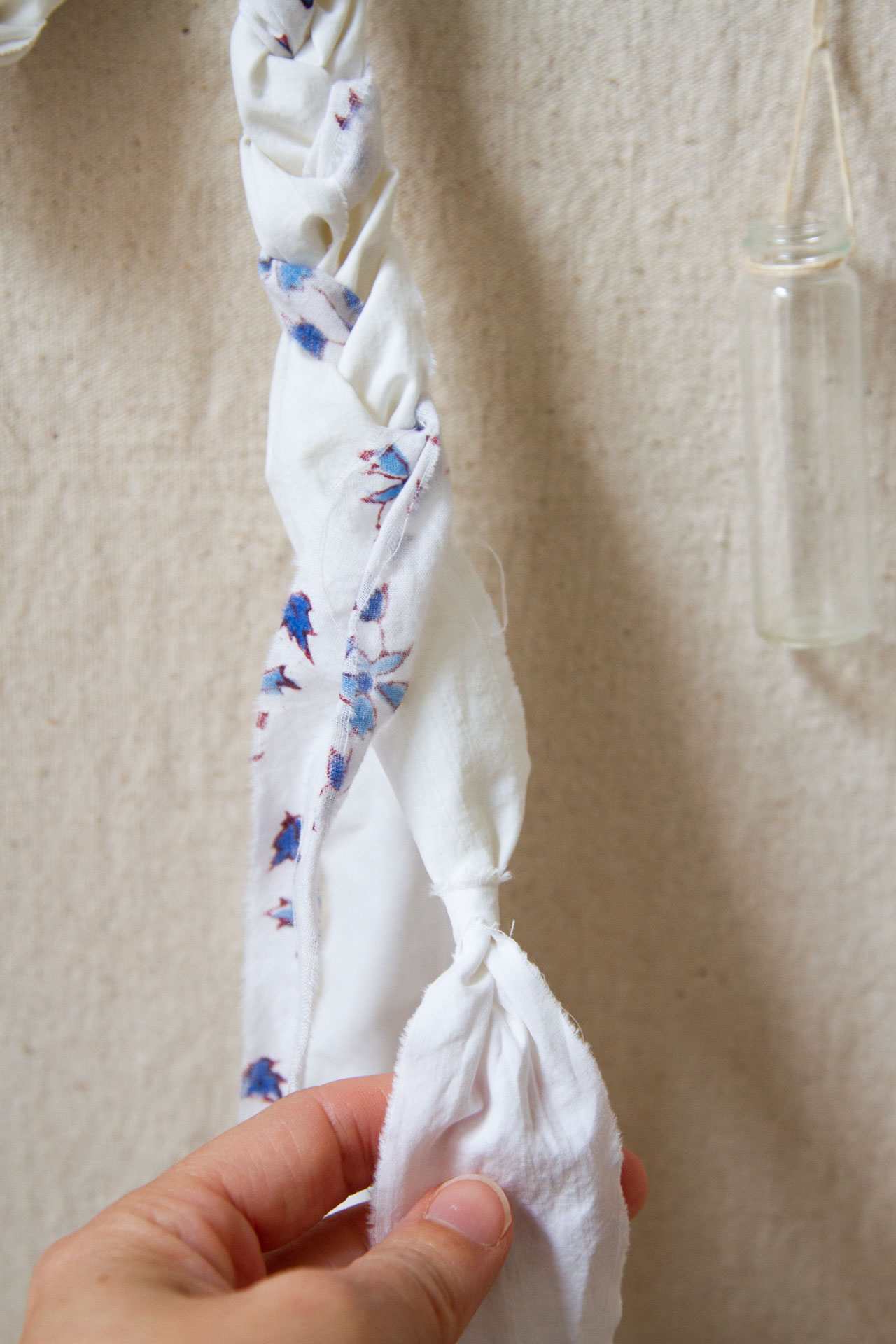
Finally, I pulled the end of the new strip until the large loop became small a knot formed where the two strips were joined together. Then I continued braiding, incorporating the knots directly into the braid as I went.
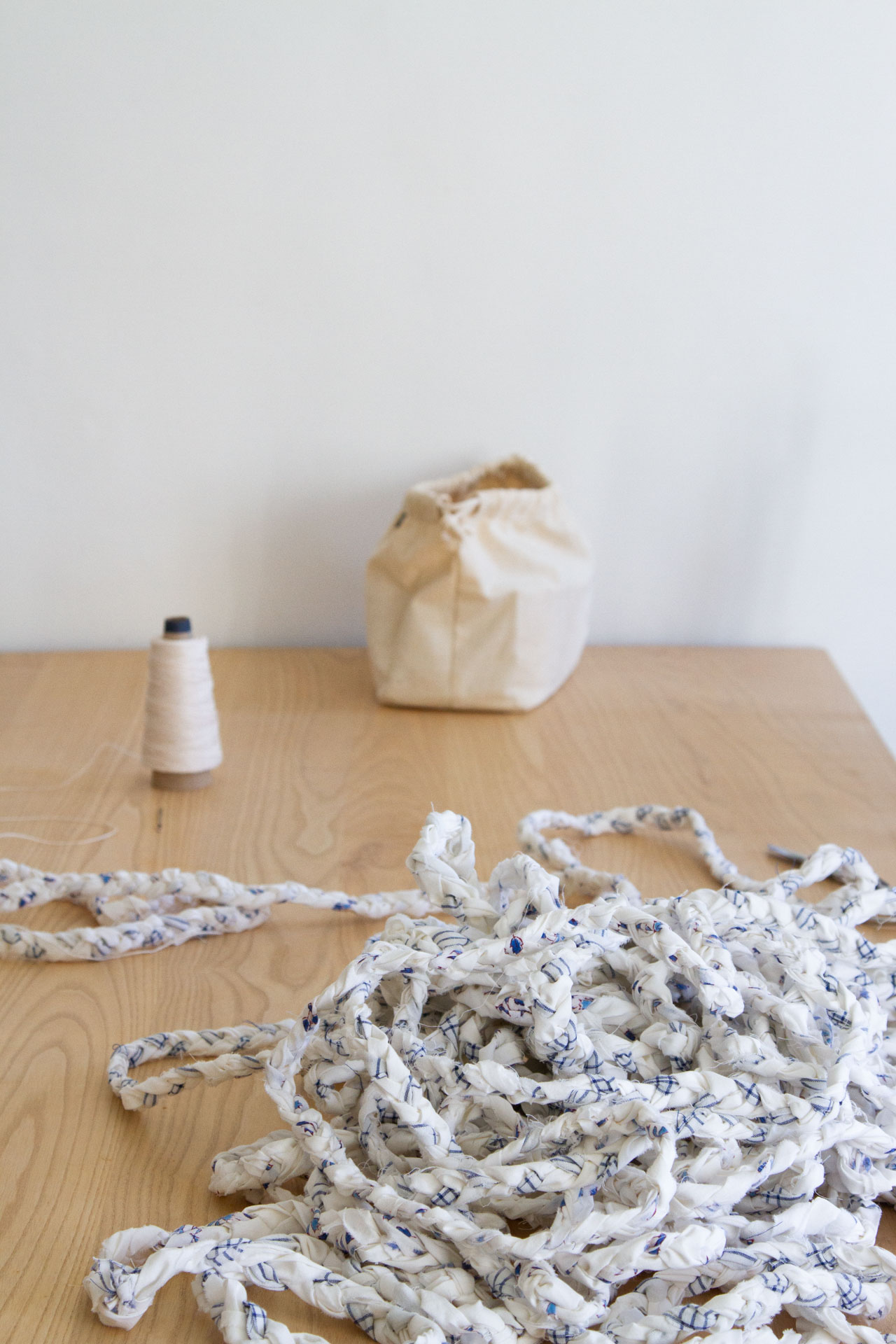
Lacing
When I had roughly 175 feet of braided rope, I began the process of lacing the rug together.
There are lots of ways to go about this, but I chose a method that uses lacing instead of sewing, meaning I used a large, blunt upholstery needle to pull linen lacing through the braided loops, instead of piercing the fabric itself with a needle or machine sewing. I tried a few different threads and strings I had at home before buying a skein of linen rug lacing thread and I’m so glad I went for the real deal. The linen thread is very strong and slides easily through the loops so it doesn’t snap or snag while tugging the braids into place.
I began lacing by forming a tight center coil that I knotted in on itself. [This video and others in the series by wool rug braider Kimberly K was helpful for me to watch as I got started.] From there, I followed a rough guideline of using an upholstery needle to pull my lacing thread needle through every other loop on my outside braid, and back up through every loop of the interior braid.
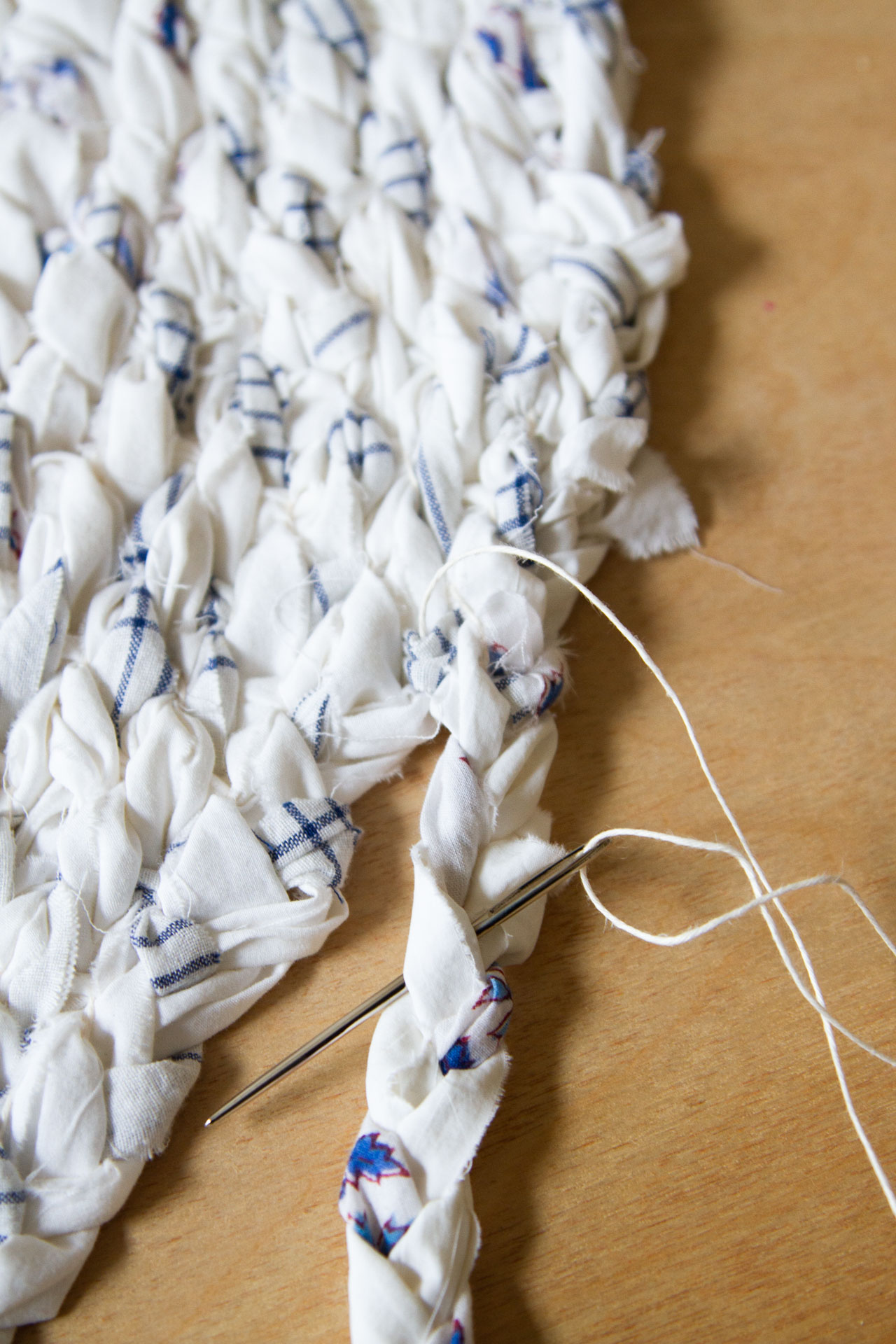
Once you have the braid and lace in hand, the process is intuitive: pushing the needle first through an interior loop of the braid on the outside of the coil…
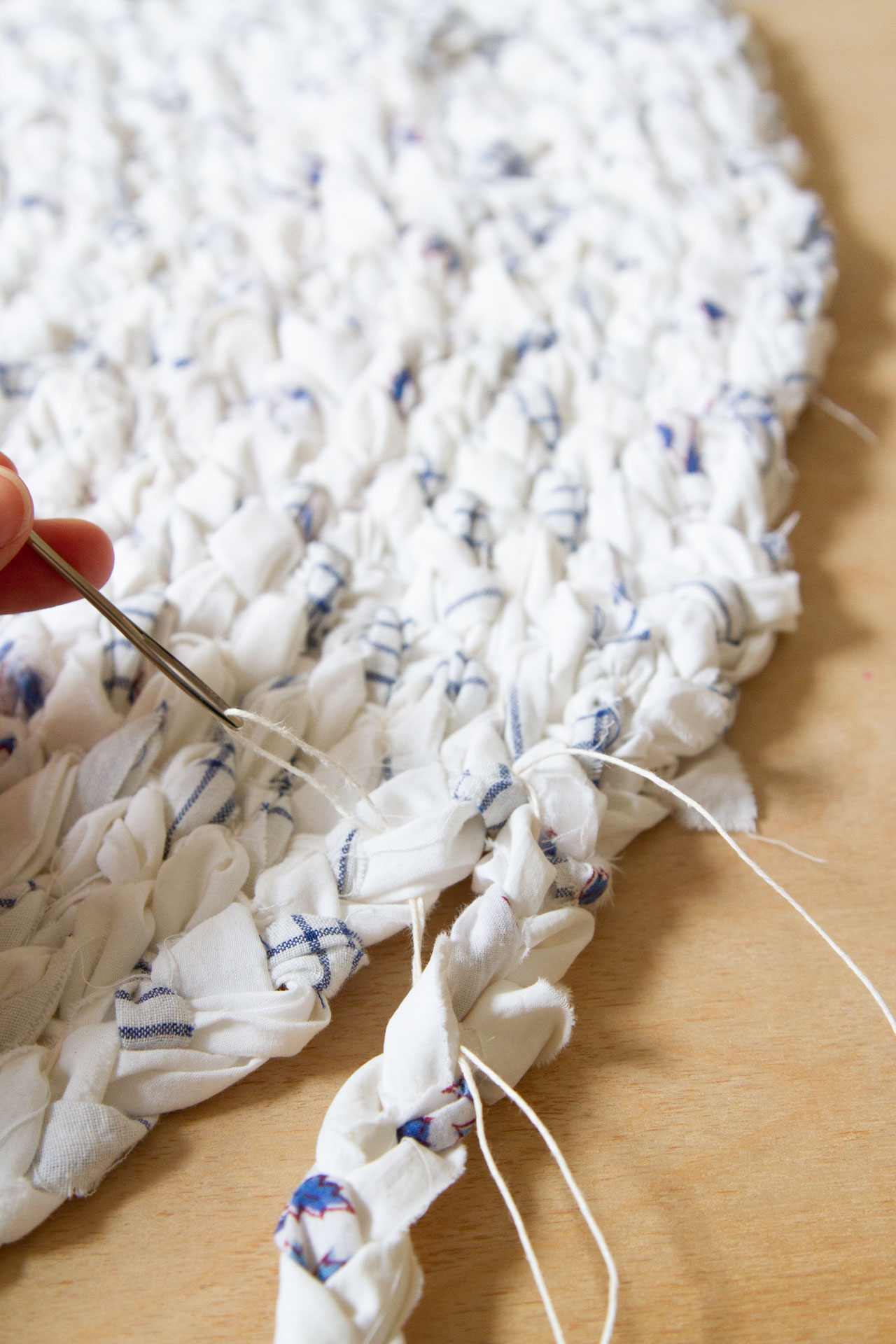
…and then bringing the lace back up through an exterior loop of the braid on the interior of the coil. Generally, I skipped every other loop in the braid on the outside and ran the lace through every loop on the interior. I worked with about 5-foot sections of lacing to prevent too much tangling and when I needed to add more, I just double-knotted the new length of lace to the existing one and hid the knot under a braid loop.
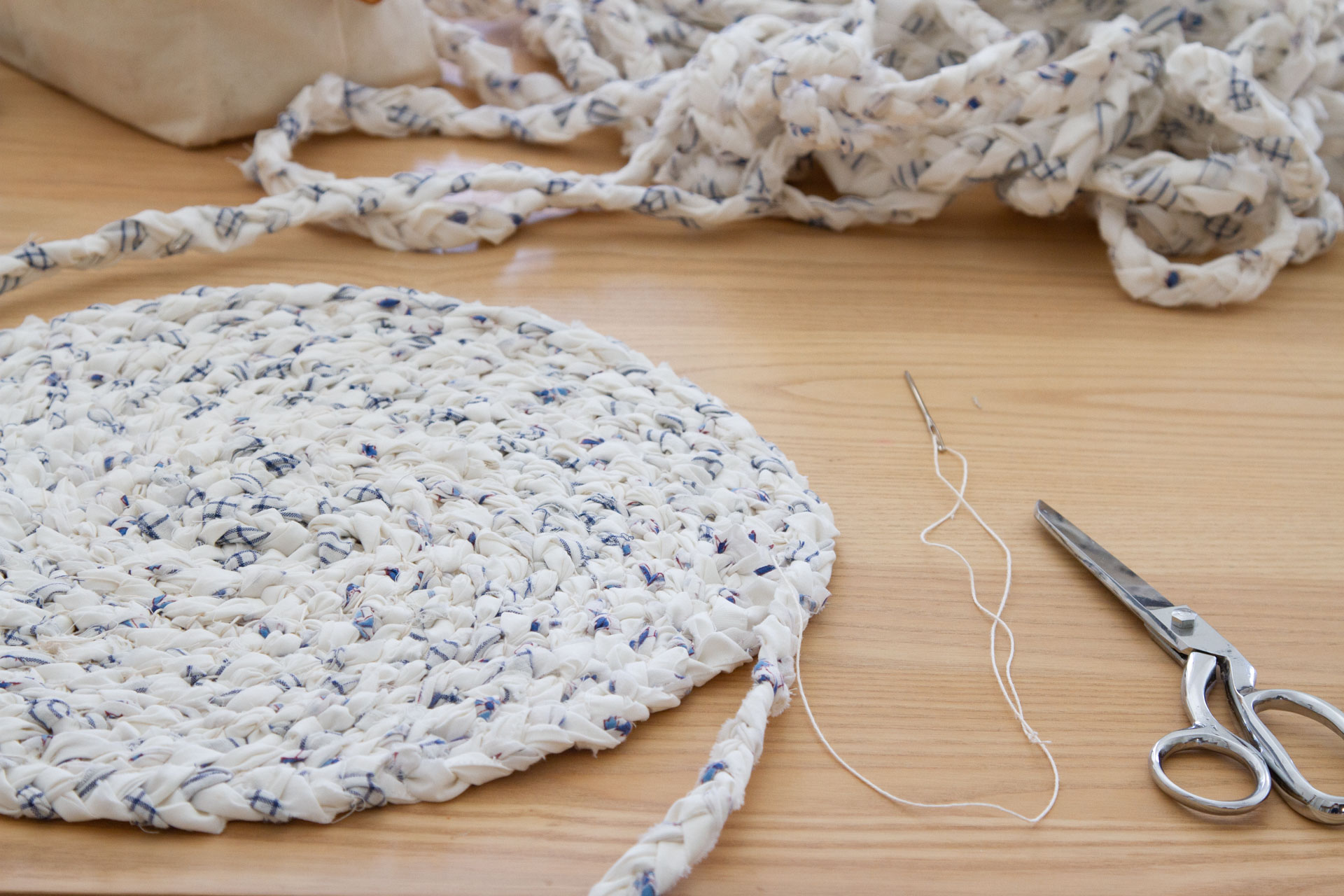
I’ve pulled together a number of short video clips through Instagram which may help make sense of this and to fill in what I failed to document in pictures, but I promise, it was very straightforward once I got going.
Finishing
In the end, my 175 feet of braided bed sheets made one 29-inch round rug. I decided to safety pin the end of my braid to the back of the rug so that I could add more lacing and additional braid should I want to. In that case, I’ll only have to join new strips to the ends of the braid and continue the process of braiding and lacing.
The rug is next to my side of the bed now, a cheerful a little orb of created comfort. It will get dirty. One day it might become so compressed and dingy gray that I’ll no longer want it on my floor. And so then it will be thing that I devoted hours of my life to that I want to relegate to the garbage pile. Of course I devote hours of my life to all sorts of things: watching the entirety of the Gilded Age in week’s time, scrolling through my phone after dark without project or point.
Was it worth it? What’s it worth? I’d be lying if I didn’t say that I felt acutely aware of the hours that passed as I laced these braids together, the linen lace cutting into my pinky. I thought of the emails that weren’t getting answered, the book proposal I still hadn’t finished, the other blogs posts that weren’t getting written in favor of braiding a very small rug that I didn’t even particularly need. But I also kept returning to these questions: How much does it cost me to read a book? To drink a glass of wine on the rooftop as the sun is setting? To spend an hour with a friend or call my sister on the phone. Capitalism would have us separate leisure and work, pleasure and production into separate spheres. If time is money then we should spend ours wisely, outsource our work to someone else in an effort to make our own lives as optimized and efficient as possible. I’d rather make a rug.
If the question is could cheaper rugs be found, then the answer is undoubtedly. But they wouldn’t have used up my old bedsheets or familiarized myself with handling the fabric, or taught me how to pull the lace taut enough that the braids cinch together but not so tight that the rows curl in on themselves. There’s value, I think, in the know-how itself; something to be gained from the process, to say nothing of the pride and intimacy embedded in the finished object.
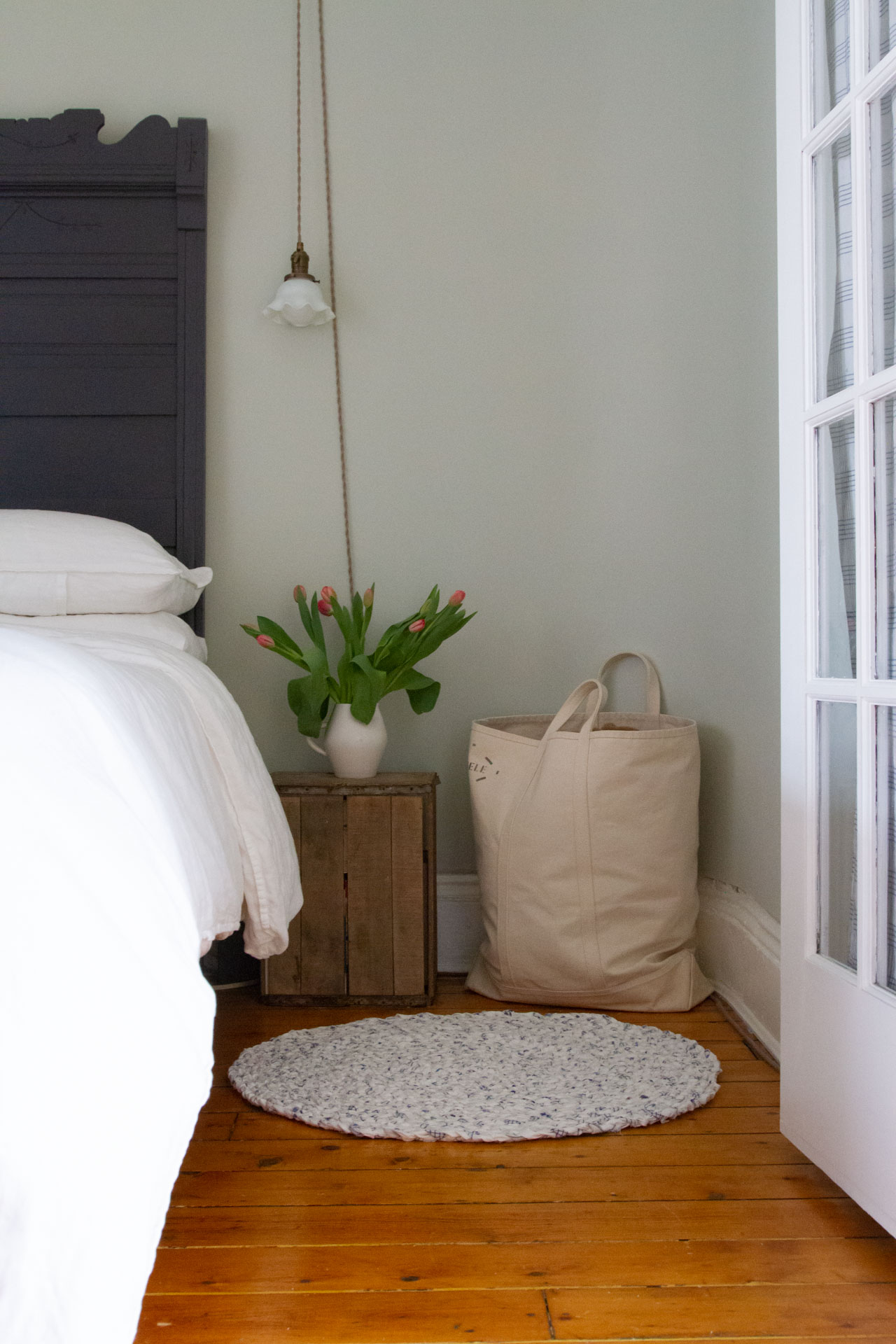
PS. As for sheets to replace the ones I ripped to shreds, we’ve been test-driving a new set of hemp sheets, generously sent my way from Evenfall. Hemp, as you likely know, is a bit of a wonder material for host of reasons including impact on the environment and strength of fiber. On our bed it feels lovely—pleasingly slubbed and rumpled like linen but lightweight and with less friction that makes it almost silky to the touch. So, if you’re thinking of shredding your current sheets into strips and turning them into a rug, I’d heartily recommend giving Evenfall a try. You can use the code TEALEAVES for 15% off your purchase now through April 4, 2022.
The above is an affiliate link which means that Reading My Tea Leaves might earn a small commission on the goods purchased with this code. If you’d prefer, you can make a direct contribution to Reading My Tea Leaves.

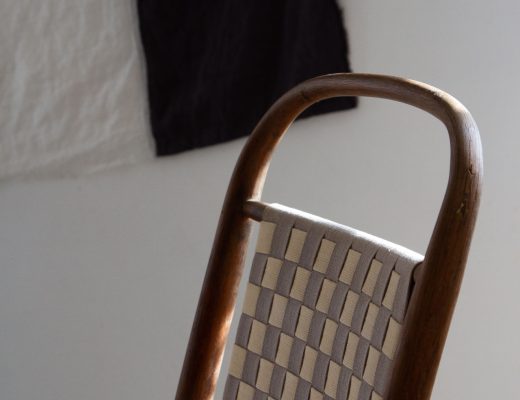
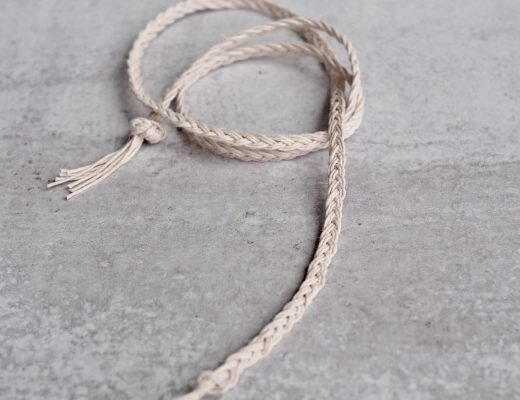
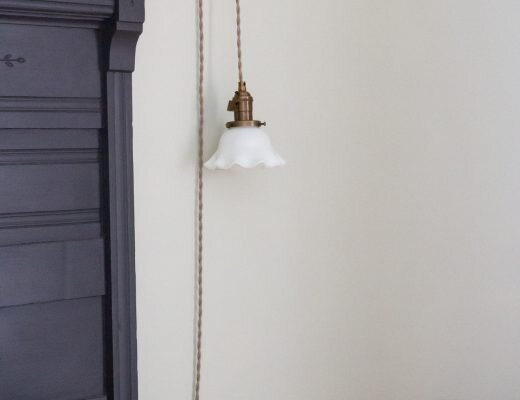
42 Comments
Love this! Do you think it would hold up in the wash? Do you plan to hand wash or wash at all? Curious about lacing vs sewing technique and long term durability, even with the expectation that it will someday head to the bin.
I think I’ll hand wash!
Hi, Erin! Thanks for your insight in making these beautiful rugs!! Does your method of lacing the braid result in the braids lying on edge with the wider surfaces adjacent, or more flat with the thinner sides of each braid being joined adjacent?
flat! thinner sides adjacent!
I applaud your patience, and your musing about time is so spot on. I tried this years ago with t-shirts, using a crochet hook instead of a three-strand braid, then sewing with regular thread (didn’t know about the lacing, that would have been a huge improvement!). In the end, I ran out of patience, and was disappointed with what I had to show for it. Oh well. Still love braided rag rugs, and now know from experience how much time and skill it takes to make a sturdy thing that we end up just throwing on the floor. It’s good perspective.
I took a rug weaving class a few years ago. We used jersey strips, offcuts from a local screen-printed clothing shop that has a zero-waste practice. We wove on very simple, large looms made of canvas stretcher bars, and it took hours to finish the rug at home afterward. I put my feet on it every day, four years later. I’ve hand washed it and machine washed it. It is one of my most-loved objects.
While we were learning, Lucy (the instructor) told us some history of rag rugs and the cycle they would go through, and while it doesn’t fit my city-life, it’s beautiful.
Weavers would make cloth. Cloth become bedding or clothing. They get worn and mended and worn out. The worn fabric would be turned into a rug. First the rug might hold a place of honour near a fire, or by a bedside. After being trampled down, it would move to outside the entryway. After that it would move to the barn or shed, for kneeling on while milking, or making a soft space for a farm animal to lay down. Eventually it would be worn through and discarded.
I don’t have cows to milk or a fire to sit by, but I love that I have this story. It makes me find value in my interest in materials and clothing, out of a utility and waste cycle and into a process of respecting the fibres and using them for all they’re worth.
That’s a beautiful story, thank you for the infomation Emily! It also kind of reminds me of the “path” the clothes in our family normally take: from impeccable (for the office/special occasions), to worn/slightly washed out but still good for everyday/leisure (outside work), to “may run the risk of being destroyed” for pants/jeans (painting, hiking, playing with kids on the playground) or sleeping in (for soft long sleeves or t-shirts). I actually have a couple of hole-y sleeping long-sleeves in my drawer, waiting for the cold season to end to be ripped and knitted into potholders. For one of the shirts, that would be a live span of 16 years and counting.
This subject is near and dear to my heart. Over her lifetime, my grandmother made dozens of braided wool rugs. When the time came for her house to be cleared out, I took four or five of them home with me. They are probably 40-50 years old and still look incredible. A braided wool rug can also be flipped over once the top is getting worn, and it’s like having a new rug. Magic! My patient, industrious mother has also revisited the art of braided wool rugs and spends her winters doing that before the growing season starts. She scours thrift stores for wool garments, rips them into strips, rolls them into balls, and then uses those to make her rugs. It is a true labor of love.
I lika this project and now I am the mood to make a rug again too!
Apparently my great-grandparents used to get a bit more use out of worn sheets by cutting them up the middle, then sewing the two halves back together the other way round – so the middle became the edges and vice versa. After using it like that for a while, I’m sure it was repurposed again, perhaps into a rag rug (northern England – probably a ‘proggy’ or ‘proddy’ mat rather than a braided one).
Lovely! I made several travel / curly-hair towels from a torn bed-sheet. smooth towels do wonders for curly hair.
While I don’t like the idea of making you speak ill of any sponsors/partners, I wonder if you’d be willing to update your bedding post with details about how various sheets held up. One thing I miss when researching items is the long-term review: how has something held up over time? I so often trust your reviews, and it would be great to hear which sheets hold up best. It’s crazy to me that some vintage sheets are still in my household rotation, while $200 sets wear out within just a few years. I’d like to buy something that I can trust will last at least for a decade, maybe more!
You know, since we got them all at the same time and they all gave out at about the same time, I’d say they all had about a five-year lifespan. Couldn’t really say that any held up any better than others. Caveats abound of course, but probably most important to know is that we don’t have a washer or dryer in home and so we have to send all of our linens to the laundromat which is notoriously hard on sheets. I have high hopes for these hemp sheets, but of course can’t speed up time!
Goodness, 5 years doesn‘t seem much Even my super cheap Ikea sheets last better than that. In fact, in 38 years of homemaking I can‘t think of more than one or two items of bedding that actually tore and I believe they had been passed on from relatives who had used them for years before that…!! I would say I use my bedding for about 10-15 yrs before passing it on – intact – and enjoying something different in style.
At least you made something nice out of the rags.
I have made rectangular ones by knitting on very large needles! It works well and I used the rugs for years and years (and washed in the washing machine). Yours looks beautiful!
oh, i’m going to try this next! i see a bathmat in my future!
That’s a brilliant idea! I love knitting with 50 gauge needles and could see using two or three strands of sheets at a time to get the desired thickness.
This is so lovey Erin! I just signed up for a rug braiding class with the proprietor of Swanson’s fabrics and wanted to share a link in case other folks were interested. Her style is braided into itself— e.g. no sewing at the end! So cool that one craft can have so many modalities.
https://www.swansonsfabrics.com/classes-workshops
This post is a goddamned delight.
Beautiful post and really relevant conclusion ! The philosophy included in it is so reassuring.
I’m curious if you have any intel that hemp might be hardier than linen. I prefer the feel of linen sheets, but they seem to wear out much faster than cotton.
Hi Jessica! I have a little insight- most vegetal fibers are at their weakest when they are wet. Linen is especially tender in water (and with heat) so it can wear quickly in the wash. Washing linen sheets alone, on cold, treating them very gently as you remove them from the wash and air drying them can make them last longer but they’re still quite biodegradable (not a bad thing!). Hemp as a fiber is an outlier and does not weaken so much when wet. That being said- the process of taking a plant’s woody stalk and making it into thin, white, soft sheets involves a level of breaking down that will speed up wear and tear even with ol’ toughie hemp. Less processed fabric lasts considerably longer, but holds more of that woody stalk memory that few seem to relish in bedsheets.
Thanks so much, Grace!
I believe we were created to be creators ourselves…and exactly what you said: that creating can be an act of resistance in our human constructed capitalistic society. What you make can have a purpose, but it doesn’t have to, the important thing is just to create! I made a button up shirt from I think the same set of sheets you had (Coyuchi organic percale). I didn’t need the shirt but it gives me joy to wear and to know it’s from something that others would have seen as trash. There is so much possibility from a good sheet!
Over the winter I made a tee-shirt rug, it is crocheted and I imagine far easier than making a braid rug. I used old(some well-loved ) tees.
It isn’t as beautiful as your little round cozy, but I was proud of the energy spent. And that I saved the very worn tees from landfill. I’ll use it as a mat by the campfires. And like you, I delight in having learned something new.
Thank you for your inspiration and sharing with us. I appreciate your devotion, both on the rug making process and saving the environment.
Your rug is beautiful, and very you. Congratulations on your perseverance Erin.
Anyone interested in making a virtually no-sew braided rug should check out the class and resources offered by Kathryn Swanson at swansonsfabrics dot com. I took the class over zoom and also made a rug out of old sheets, but she recommends using up old polyester and “gross” fabrics because their smoothness makes them really well suited, and keeps them out of landfill since they aren’t going to break down anyway. She says it’s easy enough to do “in bed” and the rugs are so heavy and sturdy once you get going! The only thing I would do differently is machine sew the strips together because I just don’t have patience for handsewing. Thanks for sharing your experience with traditional braiding Erin!
I really love the idea of this. Although very much a DIY’er when it comes to items in the home, I’ve abandoned many of my usual pursuits during the pandemic. But this sparks my interest and I happen to have some sheets ready to be recycled in some way.
Your rug looks very nice. My mother did this years ago. I cut strips and sew them together. Then I crochet them in the round or in an oval using a very, very, big crochet hook. I try not to pull too hard and make the loops too tight. The rugs lay flat when I am careful. My method does take time, and it is hard on the hands. Mine wash easily in a machine. I air dry them. They are tough and hold together very well.
What a sweet little project and labor of love! It’s amazing what we can pull together when we spend our time intentionally on projects that fill our hearts (and homes) with goodness. May you enjoy your rug for years to come 🙂
Lovely writing! I made a rag rug from old tshirts many years ago now and while the colors are not what I would pick necessarily for my kitchen, sometimes that’s nice too to just use what I have.
A book I still remember fondly from my childhood is Something from Nothing – it follows a baby blanket through it’s life cycle as it’s worn out and repurposed over time – as a jacket, a tie, finally a button. As a kid I loved the magical feeling of reinvention, what will it become next?
Admitting my own limitations here (space, time, mental, emotional, etc), and taking this as inspiration to make a few braided baskets! Thanks, as ever, for the the gentle nudge.
This reminds me of the time I made a tiny rag rug for my Kirsten American Girl doll as a kid, as part of some kind of kit I got. I haven’t thought about that in years! 🙂 I would love to make an adult-sized one now. Thanks for this lovely post!
I love the idea – plans for the future! I also love the jeans you’re wearing in the video of you tearing the strips. Any chance you could share where they’re from? I’ve been searching for a pair just like them! Thanks!
They’re by Rudy Jude!
Such a cute rug! Just a random tip if you find yourself with more old bedsheets and less time…. Animal shelters would love to have them. I live in upstate NY and our shelter here recently received over 800 (!!!) animals from an abuse/neglect case. They specifically asked for old sheets and towels to use for bedding for them. But I’m sure most shelters would be grateful to take them off your hands anytime.
This post and all of the lovely comments are very reminiscent of the book Josef had a little overcoat. It’s a favorite in our house and perhaps the encouragement we need to empty our linen closet and start a rug project. Who knows what the rug may become next.
I enjoyed your article on rug braiding. I don’t have access to Instagram so would have liked a “how-to” video or link as part of the posting, especially the lacing technique. I hope to braid a rug in the near future.
sorry to hear that you’re not able to access the instagram tutorials. that’s the easiest place for my to upload videos and also engage my audience there!
I have several rag rugs. Washed many times, used for years. Great at the door. Ready to use a pile of left over flannel for another one. Great to do while watching TV.
My grandmother made so many of these. She knew so many ways of making something out of nothing. Had to. I’ve recently been surprised by ‘new’ sheets wearing out– seems ones from years past wear longer? But, thinking about the rag rugs and found this post. Your rug looks great! A suggestion for holding strips while braiding might be to use a clipboard.
Just seen one of your lovely pictures on https://www.landofrugs.com/blog/how-to-make-an-amish-knot-rug#:~:text=To%20make%20the%20knots%2C%20you,thread%20a%20strip%20through%20later. No credit to you!
Comments are moderated.